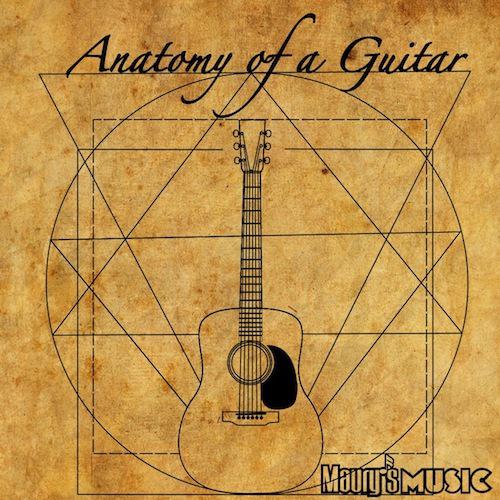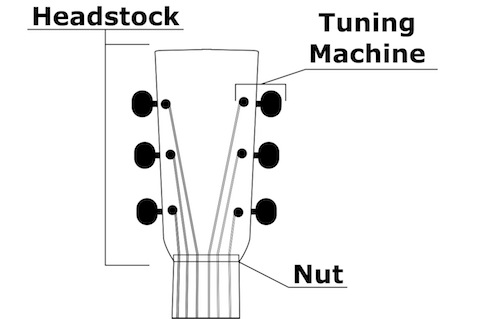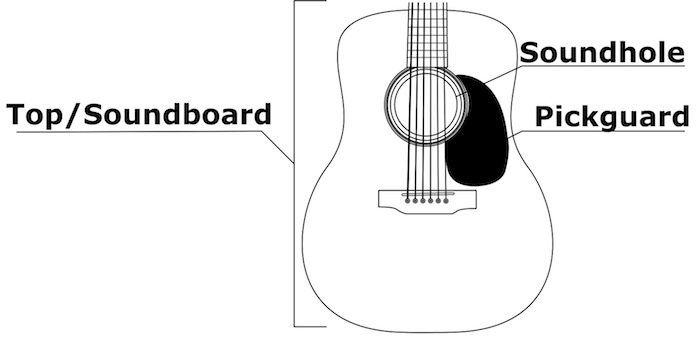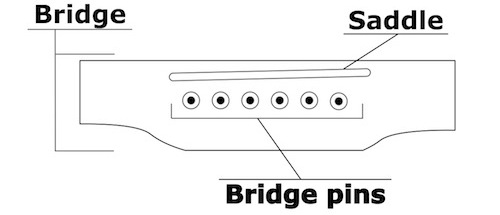
A quick note before we start: This is the second in what will hopefully be many articles to provide our customers with accurate and relevant information to help them push their playing to the next level. Think of it as a quick, casual bimonthly guitar lesson. In our first article we discussed some more advanced ideas in terms of capo use. This weeks article is going to take a step back for players who are just beginning their journey into guitar playing. It will provide a brief overview of the basic parts of the acoustic guitar and their purpose to the function of the instrument as a whole. For those of you who are new to acoustic guitars this may seem like a lot of information. For those who already have a firm basis, this will all come across as common knowledge and may look like it is missing a lot of key points. In later articles we will dive deeper into guitar construction, taking a look at the effects of body size, braces, tonewoods and scale length. For this article though, we're going to keep things a little more simple. So let's, literally, start at the top:

Headstock
Found at the end of the neck on a stringed instrument. It’s purpose is to provide an anchor point for the tuning machines and, often, as a place for manufacturers to add logos and decorative flare. Headstocks can be found in both solid and slotted varieties. The style of headstock will affect the type of tuning machines and therefore exact method of stringing the guitar, but the same basic principles apply for both styles.
Tuning Machines
Tuning machines are geared mechanisms used to adjust the tension of the strings on a guitar. When stringing a guitar, the end of the string will pass through a hole in the post of the tuning machine and then will be wrapped around the post. The knobs visible on the sides of the headstock can be used to spin this post, tightening or loosening the string and, in turn, raising or lowering the pitch of the string to the player's desired tuning.
Nut
Found between the headstock and the fretboard, the nut acts as a guide to keep the strings in place. Notches are filed into the nut for the strings to rest in, keeping them from moving laterally across the neck. The nut also acts as a spacer for the strings and can be found in a variety of widths. Measured from edge to edge, nut width determines how far apart the strings will sit over the fretboard. After playing various sizes most players will develop a preference for a particular width nut based on variables such as playing style, personal comfort or hand size.

Fretboard and frets
The fretboard is the length of wood which runs down the top of a guitar’s neck, usually made of Ebony or Rosewood on an acoustic guitar. Embedded into the fretboard at intervals are pieces of wire known as frets. These frets are placed at specific points along the fretboard corresponding to particular notes. When the player presses a string against the fretboard the string will come into contact with and vibrate against the fret. The closer to the body of the guitar a fret is the higher the note it will produce. You will also notice, on the majority of acoustic guitars, inlayed dots or other shapes between certain frets of the fretboard. These are commongly known as fret markers and are there to provide a quick visual aid to the player when moving around the neck as well as some ornamental flair.

Body
The body of an acoustic guitar is made of up several individual pieces which we will discuss in detail later in the articles. What is important to keep in mind now is that the body consists of what is essentially a sound box; a hollow cavity where air can vibrate to produce the sounds of the guitar.
Top/Soundboard
The top or “soundboard” of a guiar is the primary generator of the sound on an acoustic guitar. When a player strikes a string it’s vibration is carried through the saddle to the body of the guitar. Once the vibration reaches the body the entire top of the guitar will begin to move, essentially bowing back and forth at very rapid intervals, causing the air inside of the body to move. It is this moving air that generates sound and tone of the acoustic guitar.
Because the speed and distance of this vibration correlates to the specific movements of the air, the tone of a guitar is highly dependent on the type of wood used for the soundboard. Most manufacturers use Sitka Spruce for the guitar tops, but Adirondack, Koa, Cedar and a host of others are still widely used and have their fans. To learn more about the different tonewoods, visit our guitar tonewoods page.
Soundhole
The soundhole is simply an opening (most often circular) cut into the top of a guitar. It is usually found directly below the strings between the bridge and the fretboard, but different manufacturers have made use of other locations. This hole allows the vibrating air inside of the body a place to exit, projecting the sound of the guitar forward.
Pickguard
Usually made out of plastic, the pickguard is a, usually teardrop shaped, piece of material adhered to the top of the guitar below the soundhole. They are found on most acoustic guitars although certain models aimed more at fingerstylists may ship without one. As the name implies, the pickguard's purpose is to protect the top of the guitar from damage by the pick. Many times manufacturers or individual luthiers will use the pickguard as another place to add ornamentation to the guitar.

Bridge
The bridge is a solid piece of wood or sythentic material thats purpose is to provide a solid place to anchor the strings to the body of the guitar as well as house the saddle. Like the fretboard, on most acoustics the bridge will be made of either ebony or rosewood although, as with most features of an acoustic, exceptions are always there.
Bridge pin and pin holes
Bridge pins are cone shaped pieces of either manmade or natural material, often with a slot cut down one side of the cone. Their purpose is to act as a wedge, holding the strings solidly into the bridge pin holes. Beyond this, the bridge pins are responsible for carrying some of the vibration of the string to the top of the guitar. As a result, the material of the pins will have some impact on the tone of the guitar. Most manufacturers ship their guitars with plastic bridge pins, which is essentially an acoustically dead material. Swapping these plastic pins out for ones made of ebony, bone or even more exotic materials is one of the most pupular upgrades acoustic guitar players make to their instruments. We offer a full line of replacement bridge pins.
As mentioned above, the holes these pins fit into are known as bridge pin holes. Like the slots in a nut, the distance between these holes affects the spacing of the strings and can come in a variety of different measurements, depending on guitar models. This spacing is known as Bridge Spacing. Players may also develop a preference for a particular bridge spacing depending on playing style, technique and genre of music.
Saddle
The saddle of a guitar is the main point of contact for the strings and the body of the guitar and carries the majority of the strings’ vibration to the top of the guitar. Like brdige pins, the material of the saddle can impact the tone of the instrument however the affect is often much more noticeable with the saddle than with the bridge pins. We also carry replacement saddles for Martin and Blueridge guitars.
The other purpose of the saddle is to control the height of the strings on the guitar. This height is commonly known as the “action”. The taller the saddle the higher the strings will rest above the fretboard. By sanding material from the bottom or top of the saddle (Depending on whether the saddle is glued into the bridge or not) guitar techs can lower the string height and make the guitar easier to play. They must be careful however as setting the action on a guitar is something of a balancing act. Too high and the guitar becomes uncomfortable or even painful to play. Too low and the strings will start to buzz and the guitar will lose tone. Every player will have a preference and what works for one player may be too high or low for another, depending on playing style.
Cross section of an Acoustic guitar bridge to better illustrate the relationship between the different parts.

And that about wraps it up. Keep an eye out for our next Maury's Music Lessons article where we are going to get our hands a little dirtier and take a look at different picking styles.